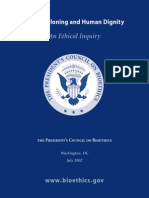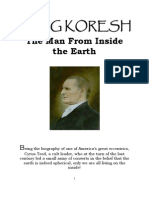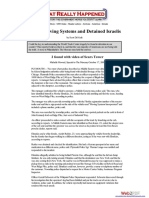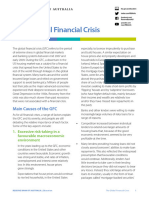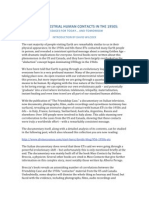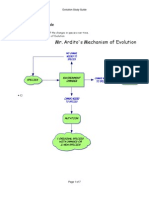Freemartin-A Small Review PDF
Freemartin-A Small Review PDF
Uploaded by
Mekala LakshmanCopyright:
Available Formats
Freemartin-A Small Review PDF
Freemartin-A Small Review PDF
Uploaded by
Mekala LakshmanOriginal Title
Copyright
Available Formats
Share this document
Did you find this document useful?
Is this content inappropriate?
Copyright:
Available Formats
Freemartin-A Small Review PDF
Freemartin-A Small Review PDF
Uploaded by
Mekala LakshmanCopyright:
Available Formats
See discussions, stats, and author profiles for this publication at: https://www.researchgate.
net/publication/332140952
Freemartin -A Small Review
Article in International Journal of Science and Research (IJSR) · March 2019
DOI: 10.21275/ART20195315
CITATIONS READS
0 77
2 authors, including:
Mekala Lakshman
PVNarshimha Rao Telangana Veterinary University, Telangana, Hyderabad
96 PUBLICATIONS 196 CITATIONS
SEE PROFILE
Some of the authors of this publication are also working on these related projects:
PG research View project
Etiopathogenesis of Primary acquired Nasolacrimal duct obstructions View project
All content following this page was uploaded by Mekala Lakshman on 21 April 2019.
The user has requested enhancement of the downloaded file.
International Journal of Science and Research (IJSR)
ISSN: 2319-7064
Impact Factor (2018): 7.426
Freemartin - A Small Review
Y. Ravi Kumar1, M. Lakshman2
1
Assistant Professor, Department of Veterinary Pathology, College of Veterinary Science, Rajendranagar, Hyderabad-500030
2
Professor and Head, Department of Veterinary Pathology, College of Veterinary Science, Rajendranagar, Hyderabad, Telangana – 500030
Abstract: Freemartin is an infertile genetic female born with a normal fertile male with which it has exchanged blood and antigens
characteristics that are unique to female and male. Freemartin or Martin Heifer is an unproductive female animal that the cattleman
should identify it at birth and save feed and development costs. Several researchers made the discovery that a freemartin results when a
female fetus has its chorion fuse in the uterus with that of a male twin. If both fetuses are the same sex this is of no significance, but if
they are different this condition will occur. When a heifer twin shares the uterus with a bull fetus, they also share the placental
membranes connecting the fetuses with the dam. A joining of the placental membranes occurs at about the fortieth day of pregnancy,
and thereafter, the fluids of the two fetuses are mixed. This causes exchange of blood and antigens carrying characteristics that are
unique to each heifers and bulls. Male hormones pass from the male twin to the female twin and these affect each other in a way that
causes each to develop with some characteristics of the other sex. Because of a transfer of hormones or a transfer of cells, the heifer's
reproductive tract is severely underdeveloped and sometimes even contains some elements of a bull's reproductive tract. The ovaries of
the freemartin do not develop correctly, and they remain very small. Also, the ovaries of a freemartin do not produce the hormones
necessary to induce the behavioral signs of heat. Freemartinism cannot be prevented; however, it can be diagnosed in a number of ways
ranging from simple examination of the placental membranes to chromosomal evaluation. Freemartins are occasionally used in stem
cell and immunology research.
Keywords: United Placental Membranes, Female fetus, Freemartin
1. Introduction the fluids of the two fetuses are mixed. This causes exchange
of blood and antigens carrying characteristics that are unique
Freemartin is an infertile genetic female born with a normal to each heifers and bulls. Male hormones (testosterone and
fertile male with which it has exchanged blood and antigens anti-Müllerian hormone) pass from the male twin to the
characteristics that are unique to female and male. female twin and these affect each other in a way that causes
Freemartin or Martin Heifer is an unproductive female each to develop with some characteristics of the other sex.
animal that the cattleman should identify it at birth and save The male hormones then masculinize the female twin, and
feed and development costs. the result is a freemartin (Padula, 2005). The degree of
masculinization is greater if the fusion occurs earlier in the
2. History pregnancy – in about ten percent of cases no fusion takes
place and the female remains fertile. The male twin is
The 18th-century physician John Hunter discovered that a largely unaffected by the fusion, although the size of the
freemartin always has a male twin (Hunter and John, 1779). testicles may be slightly reduced. Testicle size is associated
It was hypothesized early in the 20th century that with fertility, so there may be some reduction in bull fertility.
masculinizing factors travel from the male twin to the female Freemartins behave and grow in a similar way to castrated
twin through the vascular connections of the placenta male cattle (steers).
because of the vascular fusion and affect the internal
anatomy of the female (Nelson and Randy, 2005). Genetically the animal is chimeric: karyotyping of a sample
of cells shows XX/XY chromosomes. The animal originates
Several researchers made the discovery that a freemartin as a female (XX), but acquires the male (XY) component in
results when a female fetus has its chorion fuse in the uterus utero by exchange of some cellular material from a male
with that of a male twin (Tandler and Keller, 1916). The twin, via vascular connections between placentas. Externally,
discovery was made independently by American biologist the animal appears female, but various aspects of female
Frank R. Lillie, who published it in Science in 1916 (Lillie, reproductive development are altered due to acquisition of
1916). Both teams are now credited with the discovery anti-Müllerian hormone from the male twin (Rota et.al.,
(Freeman, 2007). 2002).
A freemartin is the normal outcome of mixed twins in all
3. Mechanism cattle species which have been studied. It does not normally
occur in most other mammals, though it has been recorded in
In most cattle twins, the blood vessels in the chorions sheep (Wilkes et.al.,1978), goats (Ilbery and Williams, 1967)
become interconnected, creating a shared circulation for and pigs (Bruere et.al., 1968). It does not occur in human
both twins. If both fetuses are the same sex this is of no twins because the arrangement of human fetuses in the
significance, but if they are different this condition will placenta does not allow for hormone or fetal blood
occur. When a heifer twin shares the uterus with a bull fetus, intermingling.
they also share the placental membranes connecting the
fetuses with the dam. A joining of the placental membranes
occurs at about the fortieth day of pregnancy, and thereafter,
Volume 8 Issue 3, March 2019
www.ijsr.net
Licensed Under Creative Commons Attribution CC BY
Paper ID: ART20195315 10.21275/ART20195315 1008
International Journal of Science and Research (IJSR)
ISSN: 2319-7064
Impact Factor (2018): 7.426
Gross Appearance of Freemartin [2] Nelson, Randy (2005). An introduction to behavioral
Although the male twin in this case is only affected by endocrinology. Sinauer Associates: Massachusetts. pg
reduced fertility, in over ninety percent of the cases, the 145.
female twin is completely infertile. Because of a transfer of [3] Keller, K. and Tandler, J (1916). Wiener Tieraztl,
hormones or a transfer of cells, the heifer's reproductive tract Wochensch. 3:513-526
is severely underdeveloped and sometimes even contains [4] Lillie FR (April 1916). "The Theory of the Free-Martin".
some elements of a bull's reproductive tract. The ovaries of Science 43 (1113): 611–3
the freemartin do not develop correctly, and they remain [5] Freeman G (March 2007). "Explaining the freemartin:
very small. Also, the ovaries of a freemartin do not produce Tandler and Keller vs. Lillie and the question of
the hormones necessary to induce the behavioral signs of priority". Journal of Experimental Zoology. Part B,
heat. The gonads are undifferentiated, uterus is small and Molecular and Developmental Evolution 308 (2): 105–
incomplete and cervix is usually absent. The external vulvar 12.
region can range from a very normal looking female to a [6] Padula AM (June 2005). "The freemartin syndrome: an
female that appears to be male. Usually, the vulva is normal update". Animal Reproduction Science 87 (1–2): 93–109
except that in some animals an enlarged clitoris and large [7] Rota A, Ballarin C, Vigier B, Cozzi B, Rey R (2002).
tufts of vulvar hair exist (Padula, 2005). "Age dependent changes in plasma anti-Müllerian
hormone concentrations in the bovine male, female, and
4. Diagnosis freemartin from birth to puberty: relationship between
testosterone production and influence on sex
Freemartinism is one of the most extreme forms of secual differentiation". General and Comparative
abnormality in cattle. Freemartinism cannot be prevented; Endocrinology 129 (1): 39–44.
however, it can be diagnosed in a number of ways ranging [8] Wilkes PR, Munro IB, Wijeratne WV (1978). "Studies
from simple examination of the placental membranes to on a sheep freemartin". The Veterinary Record 102 (7):
chromosomal evaluation. The cattleman can predict the 140–2.
reproductive value of this heifer calf at birth and save the [9] Ilbery PL, Williams D (1967). "Evidence of the
feed and development costs if he is aware of the high freemartin condition in the goat". Cytogenetics 6 (3):
probability of freemartinism. In some cases, there are no 276–85.
symptoms of freemartinism because the male twin may have [10] Bruere AN, Fielden ED, Hutchings H (March 1968).
been aborted at an earlier stage of gestation. Physical "XX-XY mosaicism in lymphocyte cultures from a pig
examination of the calf may also reveal differences: many with freemartin characteristics". New Zealand
(but not all) freemartins have a short vagina compared with Veterinary Journal 16 (3): 31–8.
that of a fertile heifer (Eldridge and Blazak, 1977) [11] Eldridge FE, Blazak WF (March 1977). "Chromosomal
analysis of fertile female heterosexual twins in cattle".
Genetic Marker Test: Researchers developed a DNA based Journal of Dairy Science 60 (3): 458–63.
test to identify the presence of the Y chromosome in some [12] Niku M, Ilmonen L, Pessa-Morikawa T, Iivanainen A
circulating white blood cells of the subject. Genetic testing (2004). "Limited contribution of circulating cells to the
for the Y-chromosome can be performed within days of birth development and maintenance of nonhematopoietic
and can aid in the early identification of a sterile female. A bovine tissues". Stem Cells 22 (1): 12–20.
positive test result for a heifer born twin to a bull indicates
the freemartin condition. The number of cells containing the
Y chromosome will be greatest at birth.
5. Uses
Though Freemartin calf is usually considered a negative in
the industry, some scientists are working to discover how
these can be beneficial to cattle producers. Freemartins are
occasionally used in stem cell and immunology research
(Niku et.al.,2004). Up to 95 percent of the freemartin's blood
cells can be derived from those of its twin brother. Male-
derived cells and their progeny can be easily visualized in
the freemartin tissues, as only they contain the male Y
chromosome. This model allows scientists to analyze
perfectly healthy and non-manipulated animals, without
resorting to transplantation often used in stem cell research.
References
[1] Hunter, John (1779). "Account of the Free Martin. By
Mr. John Hunter, F. R. S.". Philosophical Transactions
of the Royal Society of London 69: 279–93.
Volume 8 Issue 3, March 2019
www.ijsr.net
Licensed Under Creative Commons Attribution CC BY
Paper ID: ART20195315
View publication stats 10.21275/ART20195315 1009
You might also like
- Ethico-Legal Considerations and Issues in Maternal and Child NursingDocument19 pagesEthico-Legal Considerations and Issues in Maternal and Child NursingGi50% (2)
- SCIENCE-5-Q2-Module 4Document16 pagesSCIENCE-5-Q2-Module 4Mary Ann Gabion100% (11)
- Floral Biology Manual PDFDocument262 pagesFloral Biology Manual PDFGANESH Y96% (26)
- History of Phillip Tilton and Tabitha PrescottDocument4 pagesHistory of Phillip Tilton and Tabitha Prescottmkbair07No ratings yet
- To Know Thyself - ThomasDocument4 pagesTo Know Thyself - ThomasGeraldt GrobbelaarNo ratings yet
- Vaginal CytologyDocument20 pagesVaginal CytologyDaisy Sullcahuamán ElgueraNo ratings yet
- Free MartinismDocument16 pagesFree MartinismMuhammad Farrukh Hafeez100% (1)
- Cabinet :: Mass EffectDocument15 pagesCabinet :: Mass Effectnllano123No ratings yet
- Farewell IsraelDocument32 pagesFarewell IsraelDC RasieNo ratings yet
- Find The Argus ApocraphexDocument1 pageFind The Argus ApocraphexChriztian CriolloNo ratings yet
- Headlight 0844Document8 pagesHeadlight 0844Nancy CunninghamNo ratings yet
- HR 5404 PDFDocument4 pagesHR 5404 PDFSeniorNo ratings yet
- End Time Current Events:: Main Website 1st Alternate Site - 2 Alternative Site - YoutubeDocument22 pagesEnd Time Current Events:: Main Website 1st Alternate Site - 2 Alternative Site - YoutubeDrScottJohnsonTeachingsNo ratings yet
- U.S. Presidents and Leaders Are Agents of The Roman Catholic Knights of Malta - The Global EliteDocument37 pagesU.S. Presidents and Leaders Are Agents of The Roman Catholic Knights of Malta - The Global EliteJulija Čeh100% (1)
- Draining The Swamp: Again, You Have To Access The Web Archives Saved 294 Times Between andDocument31 pagesDraining The Swamp: Again, You Have To Access The Web Archives Saved 294 Times Between andphakNo ratings yet
- Jefferson, The Works, Vol. 1 (Autobiography, Anas, 1760-1770) (1905)Document260 pagesJefferson, The Works, Vol. 1 (Autobiography, Anas, 1760-1770) (1905)ruumrumNo ratings yet
- History of British and Foreign Bible Society PDFDocument540 pagesHistory of British and Foreign Bible Society PDFsilviaflavia79No ratings yet
- Over 60 Locations Worldwide Meet Online To Celebrate Human UnityDocument9 pagesOver 60 Locations Worldwide Meet Online To Celebrate Human Unityvladowsky100% (1)
- The Walking Dead? (Bible Zombies?) - 2012-02-19Document4 pagesThe Walking Dead? (Bible Zombies?) - 2012-02-19John Partridge100% (1)
- Proof of Earth's Shape and SizeDocument32 pagesProof of Earth's Shape and Sizejoshua.brussell82% (11)
- 610 - Benjamin Fulford Report For October 3, 2013 PDFDocument2 pages610 - Benjamin Fulford Report For October 3, 2013 PDFDavid E RobinsonNo ratings yet
- Lion of The DesertDocument4 pagesLion of The DesertNur AmalinaNo ratings yet
- Read An Excerpt From "The Snowden Files" by Luke HardingDocument6 pagesRead An Excerpt From "The Snowden Files" by Luke HardingOnPointRadioNo ratings yet
- List of Calendars - WikipediaDocument27 pagesList of Calendars - Wikipediamrrafi4521No ratings yet
- Operation Stone Garden FactsheetDocument3 pagesOperation Stone Garden FactsheetAntoinette Capasso-BackdahlNo ratings yet
- William Cooper Hour of The Time On FreemasonsDocument4 pagesWilliam Cooper Hour of The Time On FreemasonsskalpsoloNo ratings yet
- Biogeochemical CycleDocument14 pagesBiogeochemical Cyclevamos_nitin0% (1)
- Israel, Eschatology and War CrimesDocument2 pagesIsrael, Eschatology and War CrimesA.J. MacDonald, Jr.No ratings yet
- Pcbe Cloning ReportDocument340 pagesPcbe Cloning ReportAnastasiia Gordiienko100% (1)
- The Human Genome ProjectDocument19 pagesThe Human Genome ProjectSuraj Bhattarai100% (3)
- Musk Asks Court To Block Sale of Alex Jones, Infowars X AccountsDocument62 pagesMusk Asks Court To Block Sale of Alex Jones, Infowars X AccountsAdan SalazarNo ratings yet
- GeneSEE The Eclipse (March 23, 2024)Document16 pagesGeneSEE The Eclipse (March 23, 2024)The Livingston County NewsNo ratings yet
- What Is The Difference Between AD, BC, BCE, and CE in Identifying Historical Dates?Document1 pageWhat Is The Difference Between AD, BC, BCE, and CE in Identifying Historical Dates?sonalNo ratings yet
- 2019 09 19 Pilgrims Society Membership List (1902 Ca 2012) Compiled by Arlene FreeLists Org Accessed Sep 19 2019Document53 pages2019 09 19 Pilgrims Society Membership List (1902 Ca 2012) Compiled by Arlene FreeLists Org Accessed Sep 19 2019spencerjones7525No ratings yet
- 36 Questions About The HolocaustDocument1 page36 Questions About The HolocaustWill TeeceNo ratings yet
- 2003 Trafficking in Persons ReportDocument177 pages2003 Trafficking in Persons ReportU.S. Department of StateNo ratings yet
- Eisenhowers HolocaustDocument6 pagesEisenhowers Holocaustchromelung100% (1)
- DisraeliDocument9 pagesDisraelimary engNo ratings yet
- Kat Hurricane ChecklistDocument1 pageKat Hurricane ChecklistThe Southern Hustle & BustleNo ratings yet
- The Georgia Guide StonesDocument4 pagesThe Georgia Guide StonesBernardNo ratings yet
- ARK Gala 2009: Serenaded by Lily Allen Under The Arches of Waterloo StationDocument11 pagesARK Gala 2009: Serenaded by Lily Allen Under The Arches of Waterloo StationCazzac111No ratings yet
- KING KoreshDocument124 pagesKING Koresh-spectatorNo ratings yet
- #6 The Story of MosesDocument11 pages#6 The Story of MosesMary Chloe Reyes TanNo ratings yet
- Vaccination Harm Part 1Document13 pagesVaccination Harm Part 1Roberto FortuNo ratings yet
- Mythology Project-ArtemisDocument7 pagesMythology Project-Artemisapi-333988595100% (1)
- Urban Moving Systems and Detained Israelis Www-Whatreallyhappened-Com PDFDocument2 pagesUrban Moving Systems and Detained Israelis Www-Whatreallyhappened-Com PDFWhat Really HappenedNo ratings yet
- 2 - Reserve Bank of Australia The Global Financial CrisisDocument4 pages2 - Reserve Bank of Australia The Global Financial CrisisAbdel EscanderNo ratings yet
- "EASTER" - and "Babylon The Great"Document10 pages"EASTER" - and "Babylon The Great"Gabrielle Katt100% (1)
- League of Women Voters v. Ohio Redistricting CommissionDocument146 pagesLeague of Women Voters v. Ohio Redistricting CommissionAdam ForgieNo ratings yet
- Military Occupancy 2016 by Derek JohnsonDocument23 pagesMilitary Occupancy 2016 by Derek JohnsonFranck BlauNo ratings yet
- Exhibits Guantanamo Detainee ABDULRAHIM ABDUL RAZAK AL-GINCO v. ObamaDocument454 pagesExhibits Guantanamo Detainee ABDULRAHIM ABDUL RAZAK AL-GINCO v. Obamamary engNo ratings yet
- Aeneas Family Tree Brutus of Britain - Wikipedia, The Free EncyclopediaDocument7 pagesAeneas Family Tree Brutus of Britain - Wikipedia, The Free Encyclopediaemmanuel333No ratings yet
- Fundamentalism Vaccine FunVaxDocument35 pagesFundamentalism Vaccine FunVaxCathy Ann100% (1)
- The Code of HammurabiDocument2 pagesThe Code of HammurabiBaby BloggerNo ratings yet
- Hopi - From The Beginning of Life To The Day of PurificationDocument13 pagesHopi - From The Beginning of Life To The Day of PurificationSheltakNo ratings yet
- Israel Bipartisan ResolutionDocument4 pagesIsrael Bipartisan ResolutionCami MondeauxNo ratings yet
- 1950s ETsDocument77 pages1950s ETsmichaelrudd100No ratings yet
- Scott County, MO: History & Families (Limited)From EverandScott County, MO: History & Families (Limited)No ratings yet
- The Great Temple Deception: Interpreting the Highest Prophecy in HistoryFrom EverandThe Great Temple Deception: Interpreting the Highest Prophecy in HistoryNo ratings yet
- Haemato-Biochemical Observations in Emu PDFDocument2 pagesHaemato-Biochemical Observations in Emu PDFMekala LakshmanNo ratings yet
- Outbreak of Intestinal Coccidiosis Due To Eimeria Necatrix in Rajasree Birds PDFDocument5 pagesOutbreak of Intestinal Coccidiosis Due To Eimeria Necatrix in Rajasree Birds PDFMekala LakshmanNo ratings yet
- Histopathology, Cytology and Electron Microscopy Study of Turkey Pox PDFDocument6 pagesHistopathology, Cytology and Electron Microscopy Study of Turkey Pox PDFMekala LakshmanNo ratings yet
- Hemato-Biochemical and Anti-Oxidant Changes PDFDocument4 pagesHemato-Biochemical and Anti-Oxidant Changes PDFMekala LakshmanNo ratings yet
- Simulation Workshop On Complicated Caesarean Section 2022Document3 pagesSimulation Workshop On Complicated Caesarean Section 2022andrianto kurniawanNo ratings yet
- Plant Life CyclesDocument10 pagesPlant Life CyclesPotato ManNo ratings yet
- CurriculumDocument358 pagesCurriculumf.a.No ratings yet
- CAPE Biology 2012 U1 P2Document20 pagesCAPE Biology 2012 U1 P2Leah JohnNo ratings yet
- Your Complete Guide To Birth Control Methods in The PhilippinesDocument8 pagesYour Complete Guide To Birth Control Methods in The PhilippinesJobert John BatallonesNo ratings yet
- Breeding Soundness Evaluation and Semen Analysis For Predicting Bull FertilityDocument6 pagesBreeding Soundness Evaluation and Semen Analysis For Predicting Bull FertilityBahlibiNo ratings yet
- 61 Sharma and Agarwal Spermiogenesis - An OverviewDocument26 pages61 Sharma and Agarwal Spermiogenesis - An Overviewjohairah merphaNo ratings yet
- Wepik The Miraculous Journey of Life An Investigatory Project On Human Reproduction 20231027062147E42UDocument16 pagesWepik The Miraculous Journey of Life An Investigatory Project On Human Reproduction 20231027062147E42Uvineetak396No ratings yet
- MODULE 1 Lesson 3A The Sexual SelfDocument6 pagesMODULE 1 Lesson 3A The Sexual SelfJheann lojaNo ratings yet
- Genetics Mid Term PaperDocument2 pagesGenetics Mid Term PaperMeshal NoorNo ratings yet
- P2.M2 (L1-L4) Biology: Teaching Science in Elementary Grades (Biology and Chemistry)Document15 pagesP2.M2 (L1-L4) Biology: Teaching Science in Elementary Grades (Biology and Chemistry)asperaroseann926No ratings yet
- Anatomy and Physiology: Functions of The UterusDocument6 pagesAnatomy and Physiology: Functions of The UterusAnthony jesusNo ratings yet
- Short Periods of Incubation During Egg Storage - SPIDESDocument11 pagesShort Periods of Incubation During Egg Storage - SPIDESPravin SamyNo ratings yet
- Mitosis y MeiosisDocument2 pagesMitosis y MeiosisEdmundo Samaniego GuzmánNo ratings yet
- Summary Notes in Grade 7Document5 pagesSummary Notes in Grade 7Jhen BonNo ratings yet
- Lesson PlanDocument3 pagesLesson PlanBorbe ClauNo ratings yet
- Biology Chapter 2 Sexual Reproduction in Flowering PlantsDocument8 pagesBiology Chapter 2 Sexual Reproduction in Flowering PlantsYasir SalahNo ratings yet
- DLL Science Grade 7 2nd Grading 2Document27 pagesDLL Science Grade 7 2nd Grading 2roselyn bellezaNo ratings yet
- (Practice) Principles of Inheritance, Reproductive HealthDocument3 pages(Practice) Principles of Inheritance, Reproductive HealthHisto tropNo ratings yet
- Evolution Study GuideDocument7 pagesEvolution Study Guidegmanb5100% (3)
- Sexual Reproduction in Anthoceros:: Antheridium: Development and Structure of AntheridiumDocument4 pagesSexual Reproduction in Anthoceros:: Antheridium: Development and Structure of AntheridiumadekNo ratings yet
- IBALEDocument8 pagesIBALEIbale, Arjay D.No ratings yet
- Workbook Exercise Answers Chapter 18 Asal Biology PDFDocument3 pagesWorkbook Exercise Answers Chapter 18 Asal Biology PDFsrividhyaNo ratings yet
- AdolescenceDocument2 pagesAdolescenceMarrian Bonifacio GamboaNo ratings yet
- SuspensorDocument8 pagesSuspensorWaqas GhazlaniNo ratings yet
- SCIENCE 7 - QUARTER 2 - WEEK 5 - WORKSHEET 1 - Vegetative PropagationDocument2 pagesSCIENCE 7 - QUARTER 2 - WEEK 5 - WORKSHEET 1 - Vegetative Propagationjaychel Delos reyes100% (1)




























